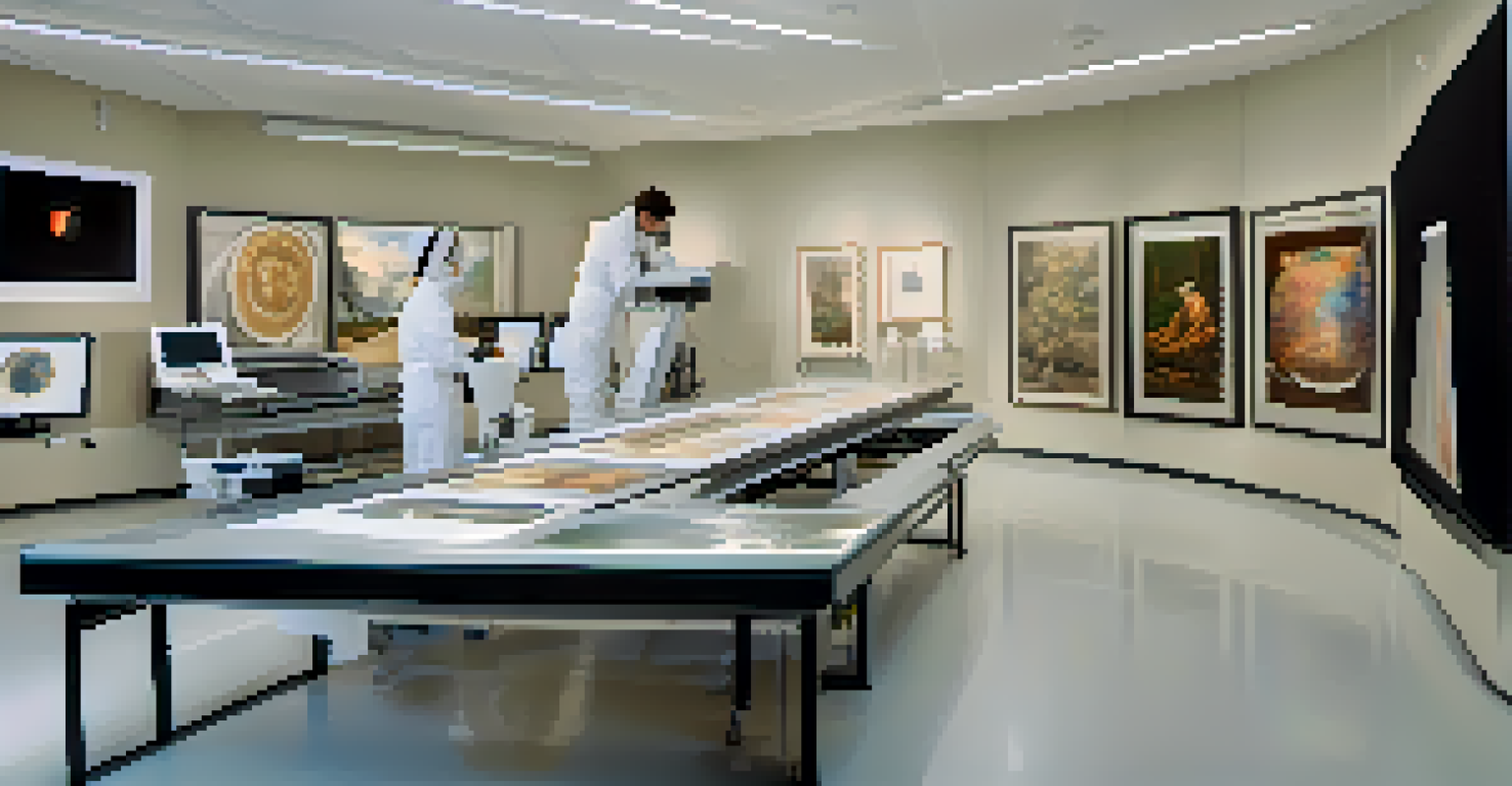The Impact of Technology on Traditional Painting Preservation

Understanding Traditional Painting Techniques and Challenges
Traditional painting techniques, such as oil and watercolor, have been cherished for centuries. These methods, while beautiful, come with their own set of challenges, including deterioration and fading over time. Artists and conservators must navigate these issues to preserve the integrity and visual impact of the artwork.
Art is not what you see, but what you make others see.
Environmental factors like humidity and light exposure can significantly damage paintings. For instance, a masterpiece left in direct sunlight may lose its vibrancy, while high humidity can cause mold growth. Understanding these challenges is crucial for implementing effective preservation strategies.
Moreover, the materials used in traditional painting, like linseed oil and natural pigments, may react unpredictably over time. This unpredictability adds another layer of complexity for those dedicated to conserving these art forms. Therefore, innovating preservation techniques is essential to ensure that these artworks endure for future generations.
The Rise of Digital Imaging in Art Preservation
Digital imaging has emerged as a game changer in the field of art preservation. High-resolution scans and photographs allow conservators to create detailed records of each artwork. This not only helps in assessing the condition of a piece but also serves as a reference for future restoration efforts.

For example, using infrared reflectography can reveal underdrawings that are not visible to the naked eye. Such insights can provide valuable information about the artist's original intentions and techniques. This knowledge is crucial for maintaining the authenticity of the artwork during restoration processes.
Challenges in Traditional Techniques
Traditional painting methods face challenges like deterioration from environmental factors, requiring innovative preservation strategies.
Additionally, digital imaging can facilitate virtual exhibitions, allowing people to experience art without physical limitations. This democratizes access to art, making it possible for anyone to appreciate and learn about historical pieces from anywhere in the world.
3D Scanning: A New Dimension in Preservation Techniques
3D scanning technology offers a groundbreaking approach to preserving traditional paintings. By creating three-dimensional digital models, conservators can analyze artworks from various angles and perspectives. This detailed representation aids in understanding the physical dimensions and surface textures of the painting.
The best way to predict the future is to create it.
Furthermore, 3D models can be used to simulate the effects of environmental factors on the artwork, enabling conservators to develop tailored preservation strategies. For instance, they can test how different lighting conditions may impact color perception over time, leading to better-informed conservation practices.
Moreover, these digital models can be shared with researchers and art historians, fostering collaboration and knowledge-sharing across disciplines. This opens up new avenues for studying art history and techniques, enriching the field as a whole and ensuring that traditional mastery is not lost.
Artificial Intelligence: Enhancing Restoration Efforts
Artificial intelligence (AI) is making waves in the art preservation realm, particularly in restoration efforts. AI algorithms can analyze artworks, identifying areas that require attention and suggesting restoration techniques based on historical precedents. This data-driven approach enhances the accuracy and efficiency of restoration projects.
For example, AI can learn from thousands of artworks, recognizing patterns in color usage and brush strokes. By understanding these patterns, AI can help restorers make informed decisions about how to repair a painting without compromising its original style. This ensures that the restoration remains true to the artist's vision.
Digital Tools Enhance Preservation
Technologies like digital imaging and AI enable more effective art preservation and restoration by providing detailed analyses and simulations.
Moreover, AI's ability to simulate potential restoration outcomes allows conservators to visualize the effects of their work before applying any changes. This predictive capability minimizes the risk of irreversible damage and supports more thoughtful, calculated approaches to art preservation.
Virtual Reality: Immersive Art Conservation Experiences
Virtual reality (VR) is transforming how we engage with art preservation, providing immersive experiences that were once unimaginable. Through VR, users can explore digitally reconstructed environments and artworks, gaining a deeper understanding of their historical context and significance. This technology bridges the gap between art and education, making it accessible to a wider audience.
For instance, a VR experience could allow users to step into a virtual gallery where they can interact with paintings while learning about their preservation stories. This engaging format fosters a stronger emotional connection to the art and its preservation challenges.
Additionally, VR can serve as a training tool for conservators, offering simulations of restoration techniques without the risks associated with handling actual artworks. This hands-on approach enhances skill development, ultimately benefiting the preservation of traditional paintings.
Ethical Considerations in Art Preservation Technology
While technology offers immense potential in art preservation, it also raises ethical questions. One primary concern is the balance between restoration and conservation. As technology enables more invasive restoration techniques, conservators must carefully consider the implications for the artwork's authenticity.
For example, using modern materials or techniques during restoration could alter the original piece in unforeseen ways. This leads to debates about whether a restored artwork still holds the same value as the original. Striking a balance between preservation and respect for the artist's intent is essential.
Ethics in Art Preservation Tech
The integration of technology in art preservation raises ethical concerns regarding authenticity and ownership of both physical and digital artworks.
Moreover, as digital records of artworks become more prevalent, issues surrounding ownership and access arise. Who owns the digital representation of a painting? How can we ensure that these digital assets are preserved for posterity? These questions highlight the need for ongoing discussions about the ethical implications of technology in art preservation.
The Future: Merging Tradition with Innovation in Art Preservation
As technology continues to advance, the future of art preservation looks promising. The integration of traditional techniques with modern innovations offers a holistic approach to conserving our cultural heritage. This synergy allows conservators to honor the craftsmanship of the past while leveraging the tools of the future.
For example, combining traditional cleaning methods with sophisticated imaging technologies can yield superior results in maintaining the integrity of paintings. This collaborative approach ensures that the essence of the artwork is preserved while enhancing its longevity.

Ultimately, the goal is to create a sustainable model for art preservation that resonates with both artists and audiences. By embracing technology, we can ensure that traditional paintings continue to inspire and educate future generations, bridging the gap between the past and the present.